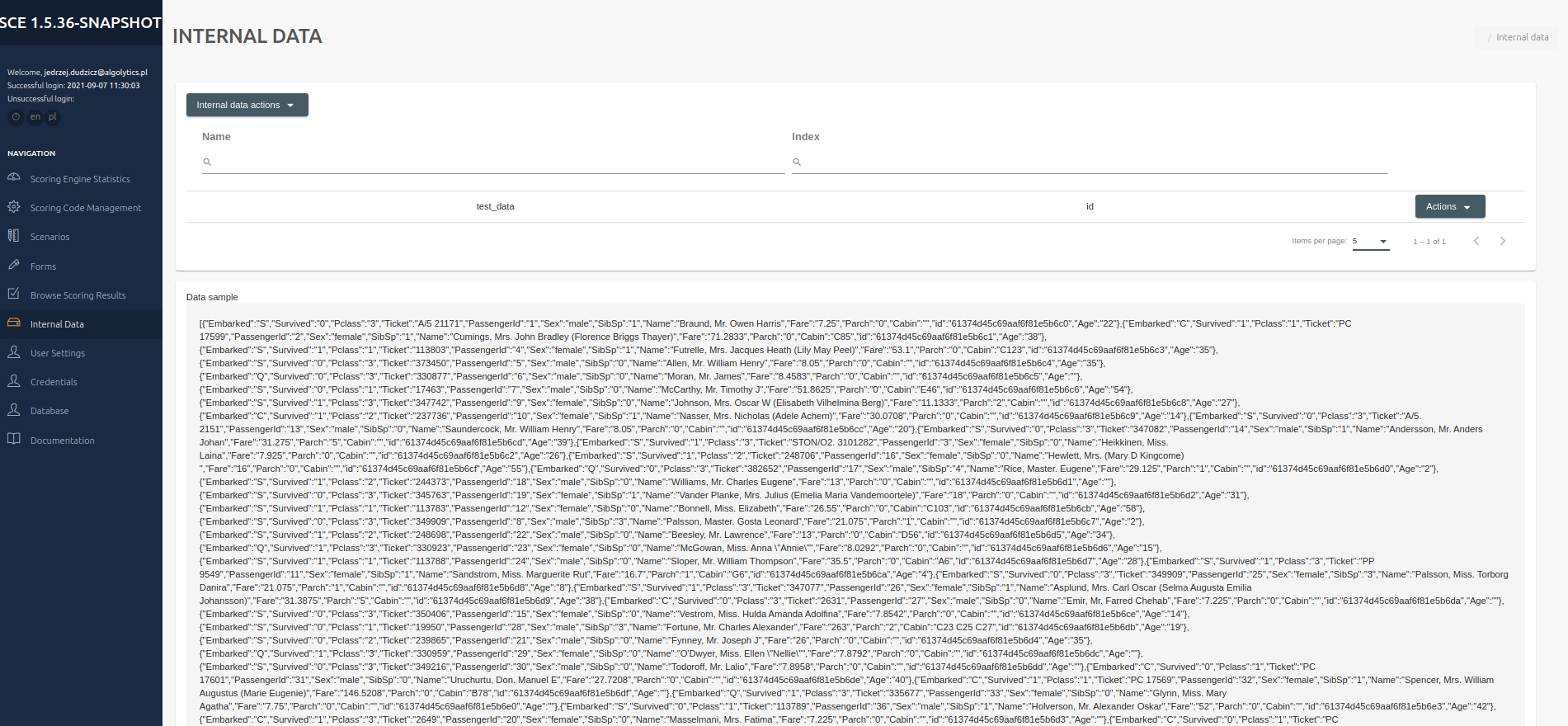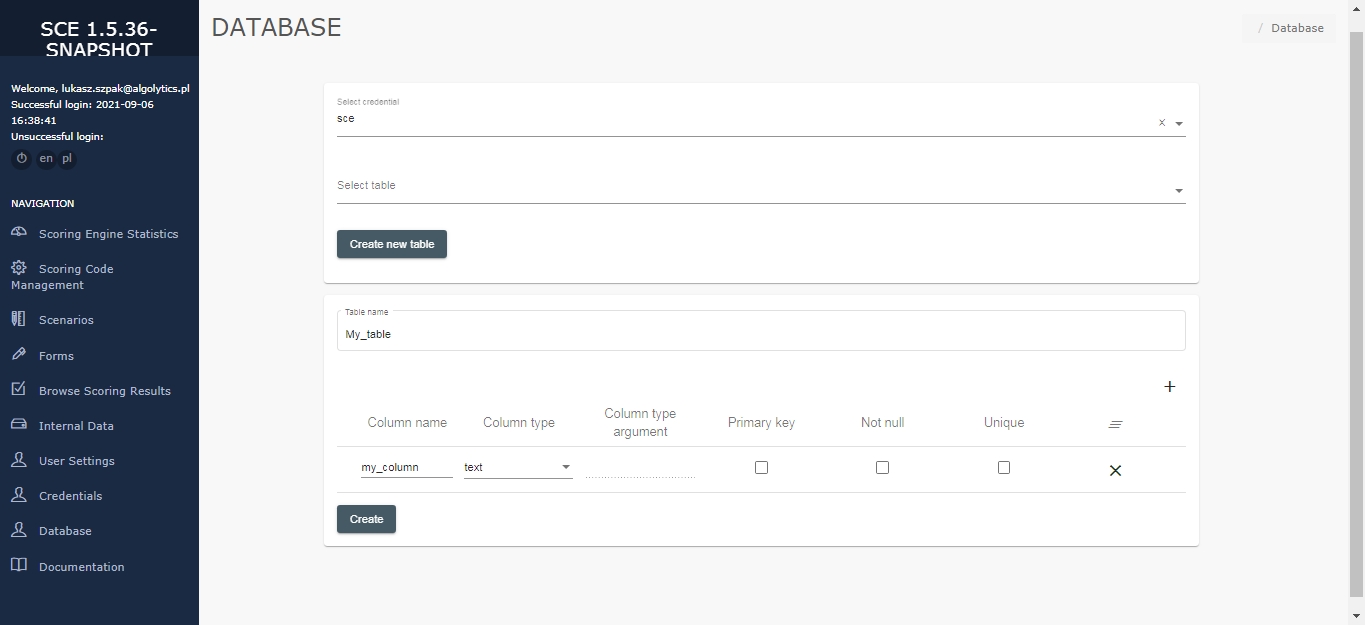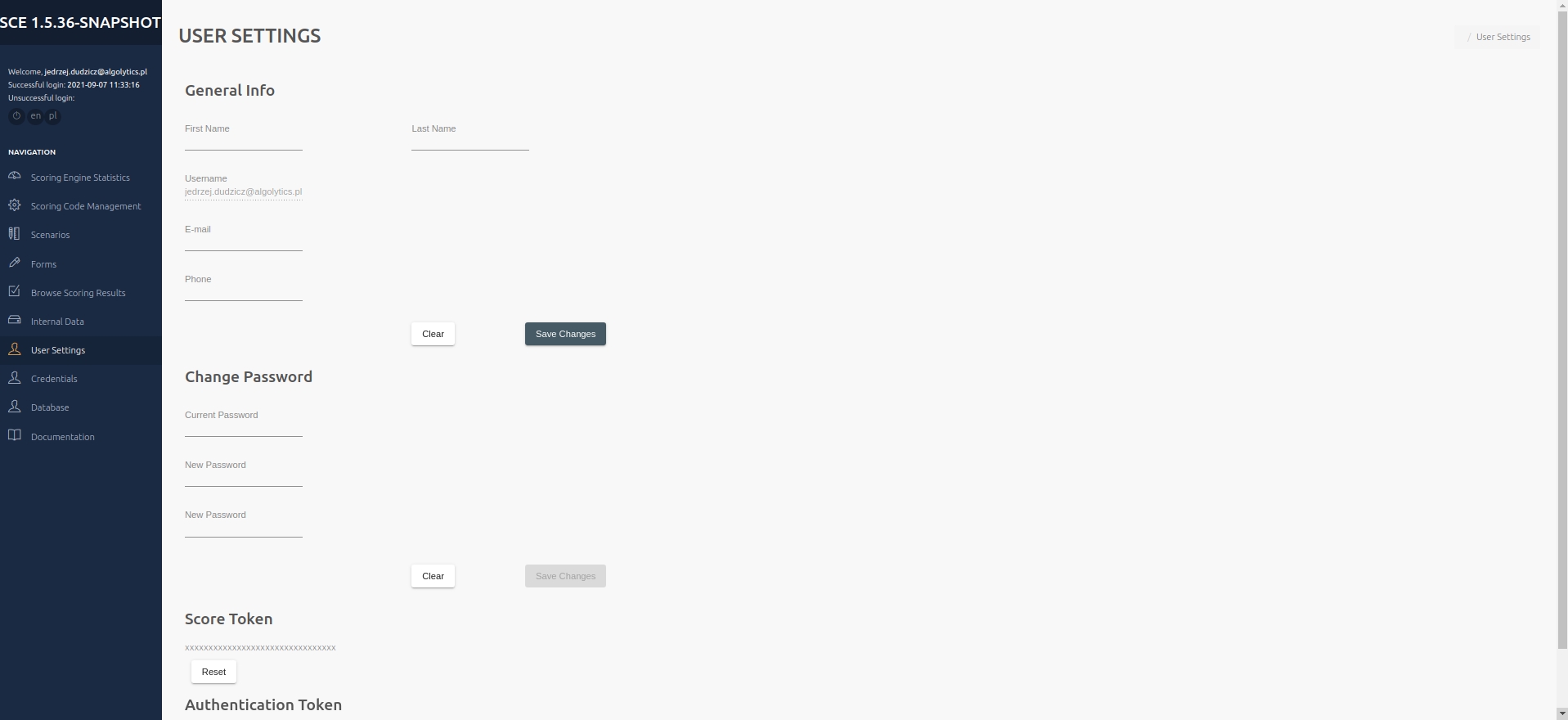Sidebar menu overview
Menu on the left side of the screen contains buttons for logging out of the scoring engine and for changing the language, and buttons directing the user to panels.

Workspace
Metrics
Scoring Engine Statistics This panel contains scoring engine statistics. On the top part of the panel shows the following two column charts: requests count and request average time. In addition, this panel contains code statistics showing the number of requests by scoring code / scenario.
Scoring Codes
Scoring Code panel is designed to add, view and export scoring codes. It consists of two parts: the button "Scoring codes actions" for adding new scoring codes and a table with information about the added codes. Selecting Upload new model will open an area for adding new code. In the upper part of the area there is the Scoring code name field, where you should enter the code name and the Type field to select the language of the uploaded program. To select a code file, drag the file to the special field with a blue border in the middle of the area, or click this field and select the file. The added files are displayed at the bottom of the area in the table. By selecting the Import from JSON option, we load the models in the JSON file as described above. The last option is Export. After clicking, the JSON file with all models will be downloaded.
The table with information about the codes contains following columns:
Name – code name
Type – code type
Class name – name of the class
User – name of the user, who added the code
Created - date of adding the code
On the right side for each code there is a drop down menu with four buttons: Export, Download and Delete, and Version. The Version button is used to set the code version, the Delete button removes the code, the Export and Download buttons respectively downloads the code in the .json format or the selected code format. After clicking on the code, 2 sections will appear: Statistics and Scoring Code Source. The Statistics section shows the code statistics: number of valid and invalid requests and maximum, minimum and average response time. Scoring Code Source shows the scoring code.

Scoring.One allows the implementation of models in four formats: Java, PMML, Python or R code. Your can read more about details in Implementation of ML models.
Scenarios
Scoring Code management panel is designed to add and view scenarios. Here you can easily export, import or copy scenarios. Scenarios are saved in the YAML format. You can export all objects from the account into one file or export objects separately. To add a new scenario, click Create new scenario button, located on top of the panel. Next to the button, there is a drop-down list containing 2 buttons: export and import, that can be used to export or import a scenario. The import button opens a window, where user must drop a YAML file or click to upload one, and a button to overwrite existing scenarios. Below there is a table with information about the scenarios, containing following columns:
Name – scenario name
User – name of the user, who created the scenario
Created – date of scenario creation
Modified – date of last scenario modification
Deployed – date of deployment
Version – version tag assigned to the deployed version
To the right, for every code there is a drop-down list under Actions button. There are four actions available: Open, Export, Delete and Copy. Open button moves the user to the scenario editor, Export button export scenario to YAML file, Delete button deletes the scenario and Copy button makes a copy the scenario.

After clicking a scenario name and then clicking on a gray METRICS field at the bottom of a screen, a scenario statistics appear. There are six metrics listed: number of correct and incorrect requests, maximum number of requests per second, maximum response time, minimum and average response time.

Forms
Forms panel is designed to query scoring codes and scenarios. The panel contains a drop-down list of scoring models, scenarios. After choosing a model/scenario, fields corresponding to model/scenario input variables will appear below. To query a model/scenario, enter values of variables info the proper fields, and click Query button. Results of the query appear in the Result panel.

Scoring Results
This panel is designed to browse results of queries. Results are presented in 5 categories, depending on result type (Scoring model, Scenario, Pmml model, R model, Python model). Category can be chosen through a drop-down list, located on top of the panel. For each category the panel contains a table with information about queries, containing following columns:
Name – model/scenario name
Type – model/scenario type
User – name of the user, who created the query
Request – input data of the query
Begin time – start time of query execution
End time – end time of query execution
Result – result of the query
Version – model/scenario version
Error – information about an error (if occurred)

Results interpretation
The Browse Scoring Result panel displays the processing logs of current queries (the panel shows the last 100 queries, and all processing records are saved in the database and stored for X days).

Logs contain sections:
Request Data - this section contains the query data.
Result or Error - this section contains the returned result or error message
Intermediate Results - contains the complete processing log of the query, a list of all graph nodes that were executed along with the values of the variables created or modified within them. Each node also includes a timestamp indicating the start and end of processing. Node names can be defined by the user (the "Custom Name" field in the node settings).
Note that FORMS panel presents only input and output data, which may by not enough for debugging purposes.
Internal Data
This panel is designed to adding CSV data. To add a new data, click Internal data actions button, located on top of the panel. Bottom to the button, there is a drop-down list containing 2 buttons: Load a CSV file and Create collection. To add a new data, click Internal data actions button, located on top of the panel. Bottom to the button, there is a drop-down list containing 2 buttons: Load a CSV file and Create collection. After selecting Load a CSV file, the Scoring Collection name field will appear in the upper part of the area, in which you should select the Colletion name to which you want to load the file. To select a CSV file, drag the file to the special field with a blue frame in the middle of the area or click this field and select the file. By selecting the Create Collection option in the upper part of the area, the Scoring Collection name field will appear, in which you should enter the Colletion name you want to create for storing CSV files. To select a CSV file, drag the file to the special box with a blue border in the center of the area, or click this box and select the file.
You can also use an API to upload your local data to the Scoring One

Databases
Database panel allow you to manage table in the Credential. Selecting Credential will show Select Table option. To manage the database, click Choose Credentials at the top of the panel. Selecting the credential will display the Select table option, where we can select tables or create a new table with the Create new table button. After selecting the Create new table option, enter the name of the new table in the Table name field. We create columns to complete the given information and confirm with the Create button.
Column fields:
Column name
Column type
Column type argument
Primary key
Not null
Unique

Credentials
Credentials panel allows you to define connections to external databases from Scoring.one level. To create a new CREDENTIAL, click the Create new Credential button at the top of the panel. Two fields will appear under the button:
Credential name
Available credential types – DATABASE is currently available for selection
Then a list with the fields will appear:
Credential type – POSTGRES and MYSQL are currently available for selection
Database host
Database name
Schema name
Database login
Database password
Confirm password

Workspaces
User Settings
This panel is designed to manage user data. The General Info section is at the top. The user name is displayed. It is possible to change the name, surname and telephone number by entering it in the gap and confirming with the Save Changes button. To reset unsaved information, press the Clear button. In the middle there is a part of the Change Passoword, To change the password, enter the current password and enter a new password and confirm it. Finally, confirm the changes with the Save Changes button. To reset unsaved information, press the Clear button. Under the Change Password section, I find the Score Token needed for the API. It can be reset with the Reset button. At the very bottom there is an Authentication Token.

Documentation
Clicking Documentation button in the menu on the left side of the screen open the documentation in new window.
Accounts (admin)
(Available only for users with administrative privileges)
Administrators can and delete new users.

Activities (admin)
(Available only for users with administrative privileges)
Administrators can check activities of all users, including time of logging in and logging out.

Last updated